Reviews
Is Duane Hanson’s Sentimentality for Working People Noble or Just Patronizing?
Hanson makes the ordinary seem extraordinary.
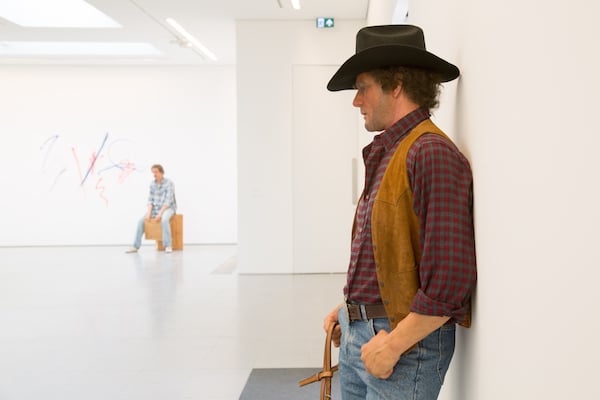
Photo: The Estate of Duane Hanson Courtesy: Serpentine Gallery
Hanson makes the ordinary seem extraordinary.

JJ Charlesworth

The preppy middle-aged couple of French tourists, giggling and snapping themselves grinning next to Duane Hanson’s lifelike Homeless Person (1991), crystallizes both the strength and the weakness of the late American sculptor’s work.
On one hand, Hanson’s often shockingly lifelike effigies of ordinary, everyday people, sitting, standing, often taking a rest from a work task, have an unswerving moral sympathy for the average folk of average America, and, by extension, ordinary people everywhere. But on the other hand, they’re novelty spectacles straight from uncanny valley—the creepy-kooky sensation that Hanson’s impeccably modelled fat housewives, blue-collar Joes, and Florida retirees might really be alive! Did he just blink?! It’s just so much fun! Take a picture of it with me!
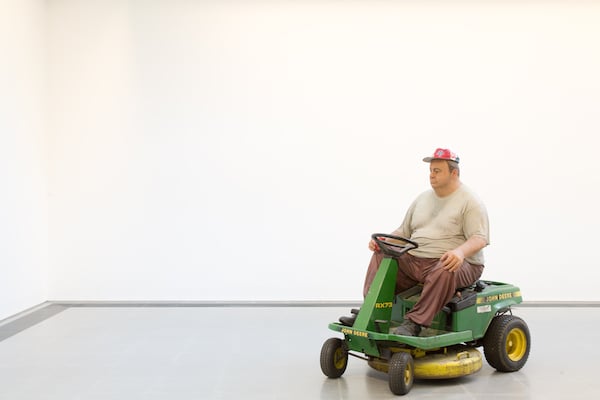
Duane Hanson, Man on Mower (1995).
Photo: The Estate of Duane Hanson Courtesy: Serpentine Gallery.
That’s the awkwardness that runs through this sharply-installed presentation of some of Hanson’s better works across the last three decades of his life (Hanson died in 1996), which are now on view at Serpentine Sackler Gallery in London. This is the period that marks Hanson’s turn to verisimilitude, sculpting in resin and fiberglass, which, while gaining him a popular audience, earned him the equal disdain of the contemporary art establishment.
Hanson’s naïve social realism—first too representational for modernists, then, too unsophisticated for high-brow postmodernists—has an intensity and care for its subjects that is endlessly well-meaning. Hanson was, it has to be said, something of a master of subtly simulated natural pose. His people lean, slouch, stand contrapposto, rest their chins on their hands at the breakfast table or hitch their thumb in their jean pockets, with an unaffected precision that triggers the sensation that we’ve seen this person, or someone like them, somewhere, perhaps everywhere, or that we recognize ourselves in those same moments of casual rest and distraction.
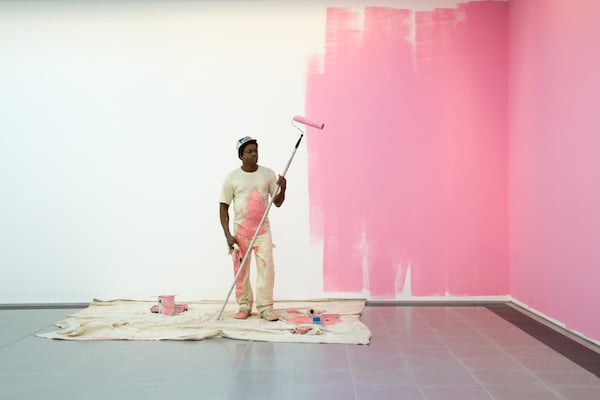
Duane Hanson, House Painter I (1984/1988).
Photo: The Estate of Duane Hanson/Serpentine Gallery.
Hanson exploits those moments of stillness in people’s lives—when they’re taking a break from a task, when they’re lost in thought, when they’re enjoying a day off or when they they’re just dog tired—because it’s those moments when they become most like objects.
It’s a melancholic ode to the gentle, existential weariness of ordinary life, but there’s a slightly cloying pathos to these Everymen and Everywomen, these representatives of unprivileged working people—the portly lady finishing her ice-cream Sundae and reading an article on weight loss while a likeness of Hanson looks on in Self-Portrait with Model (1979); the three white blue-collar construction workers of Lunchbreak (1989); or the black office cleaner Queenie II (1988), with her wheeled rubbish bin, dusters, and name badge.
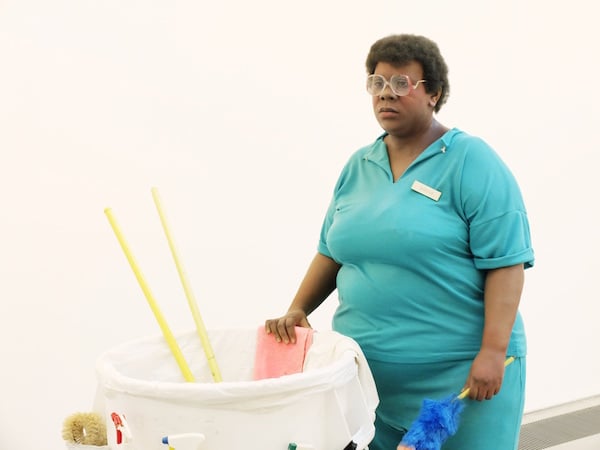
Duane Hanson, Queenie II (1988).
Photo: The Estate of Duane Hanson Courtesy: Serpentine Gallery.
Hanson’s early works sometimes railed at social and political injustices, hinted at here by the oldest work Trash (1967), a garbage can full of your usual random waste—a soap powder carton, a broken umbrella—which also, horrifically, reveals the body of a just-born baby, its head wrapped in a plastic bag, a comment, perhaps, on illegal abortion. But this stands out from the others works, which otherwise offer a more contemplative, less aggressive mode.
It may just be the weird sense of social nostalgia for 1980s America that alters how we see Hanson’s figures, but what really lingers with us—after Trash—is their mood of stoicism; or perhaps not their stoicism, but their indifference, or even their resignation—rather than their energy, their resilience or even their sense of fight. Hanson’s image of working people balances on a knife-edge between empathy and condescension for the downtrodden who can do nothing little about their circumstances.
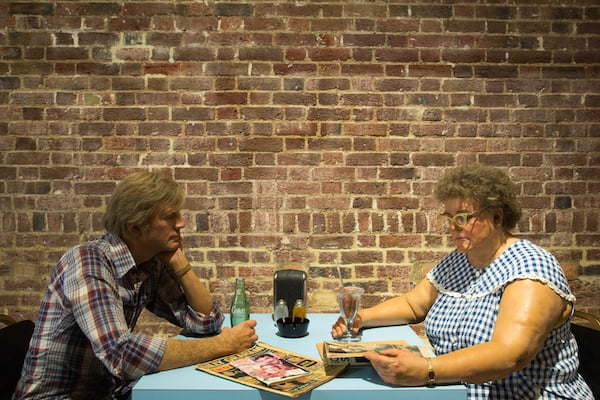
Duane Hanson, Self-Portrait with Model (1979).
Photo: The Estate of Duane Hanson Courtesy: Serpentine Gallery.
And in the pristine halls of the art gallery, this contrast between these archetypes of so-called ordinary life grates against the fashion-sense and the self-confidence of your everyday contemporary art-gallery public; the city-hopping cultural tourists with their colourful, box-fresh trainers and leisured demeanour, the gallery attendants with their black draped outfits and hipster haircuts.
And that makes you starkly aware that Hanson himself never really turned his eye to that world—the cosmopolitan, metropolitan world of people who spend their time going to art galleries—the trendy, the aspirational, the well-off.
Hanson’s only hint of self-aware irony comes with 1994’s Flea Market Lady, a sun-hatted dame comfortable in a folding chair, selling old paperbacks and dime-store oil paintings of landscapes, a sign marked “books and art ½ off.” Hanson’s message seems to be: Art is a private taste, nothing to get too worked up about. Why care about it so much?
Maybe Hanson’s work was a bid to force this world—this “art” public—to acknowledge the “other” world, that of cleaners and builders and housewives, and what he supposed was their greater sense of realness and authenticity and sincerity.
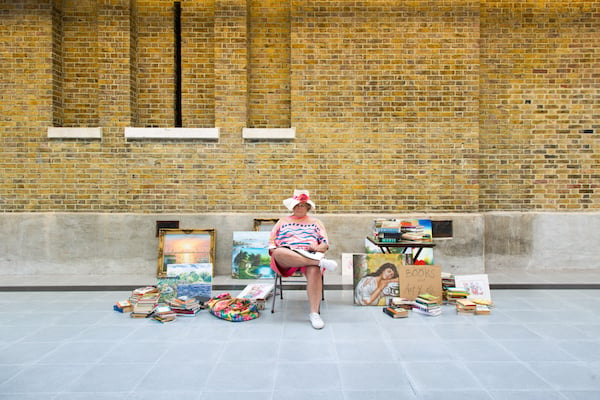
Duane Hanson, Flea Market Lady (1990/1994).
Photo: The Estate of Duane Hanson Courtesy: Serpentine Gallery.
But that authenticity was an idealization on his part. Hanson once said that nowadays we “have what we want, but don’t want what we have,” as if modern society, even with its everyday prosperity, could only generate boredom and disaffection, the ennui from which his subjects are seen to suffer.
Now, that smells a bit too much of condescension—it’s always the well off who decide that the rest should be happy with what they have, and this sentimentality for “ordinary folk” smacks of bad faith.
Walking away from the cleaner “Queenie” getting selfied by some Italians, to the Serpentine Gallery’s other space to see the show of portraits by Lynette Yiadom-Boakye, I pass another cleaner—real, alive, this time—sweeping up cigarette ends outside the gallery entrance. Maybe he wants sympathy. I suspect he’d probably, given the choice, settle for better wages. And more free time to hang out in galleries, or whatever it is he feels like doing.
Duane Hanson is on view at Serpentine Sackler Gallery from June 2 – September 13, 2015.
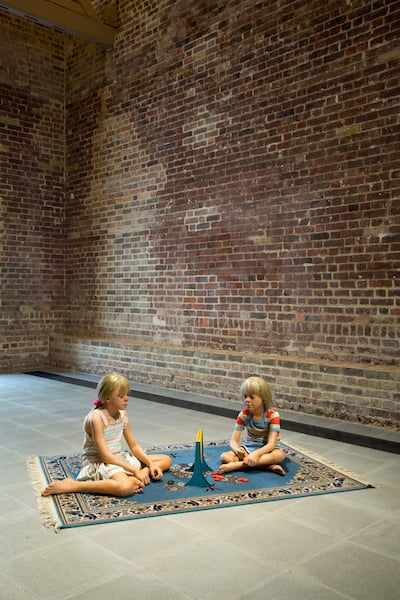
Duane Hanson, Children Playing Game (1979).
Photo: The Estate of Duane Hanson Courtesy: Serpentine Gallery.